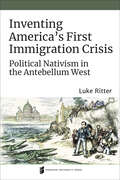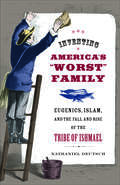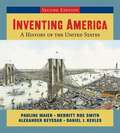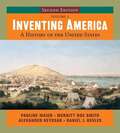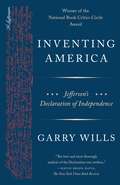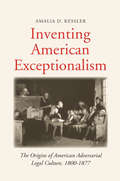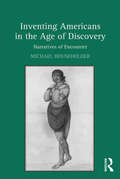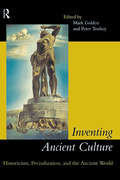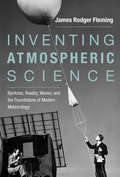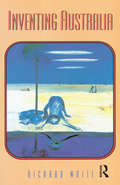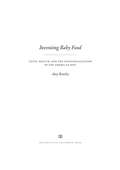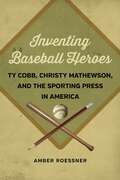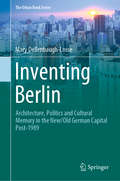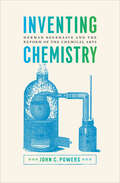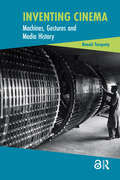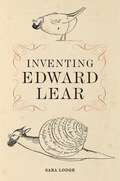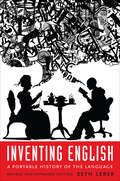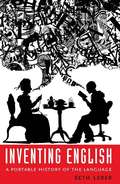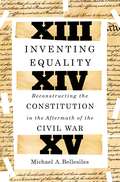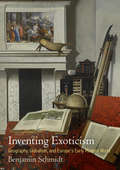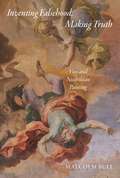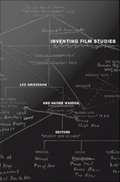- Table View
- List View
Invented by Law: Alexander Graham Bell and the Patent That Changed America
by Christopher BeauchampChristopher Beauchamp debunks the myth of Alexander Graham Bell as the telephone's sole inventor, exposing that story's origins in the arguments advanced by Bell's lawyers during fiercely contested battles for patent monopoly. The courts anointed Bell father of the telephone--likely the most consequential intellectual property right ever granted.
Inventing America's First Immigration Crisis: Political Nativism in the Antebellum West (Catholic Practice in North America)
by Luke RitterWhy have Americans expressed concern about immigration at some times but not at others? In pursuit of an answer, this book examines America’s first nativist movement, which responded to the rapid influx of 4.2 million immigrants between 1840 and 1860 and culminated in the dramatic rise of the National American Party. As previous studies have focused on the coasts, historians have not yet completely explained why westerners joined the ranks of the National American, or “Know Nothing,” Party or why the nation’s bloodiest anti-immigrant riots erupted in western cities—namely Chicago, Cincinnati, Louisville, and St. Louis. In focusing on the antebellum West, Inventing America’s First Immigration Crisis illuminates the cultural, economic, and political issues that originally motivated American nativism and explains how it ultimately shaped the political relationship between church and state.In six detailed chapters, Ritter explains how unprecedented immigration from Europe and rapid westward expansion reignited fears of Catholicism as a corrosive force. He presents new research on the inner sanctums of the secretive Order of Know-Nothings and provides original data on immigration, crime, and poverty in the urban West. Ritter argues that the country’s first bout of political nativism actually renewed Americans’ commitment to church-state separation. Native-born Americans compelled Catholics and immigrants, who might have otherwise shared an affinity for monarchism, to accept American-style democracy. Catholics and immigrants forced Americans to adopt a more inclusive definition of religious freedom. This study offers valuable insight into the history of nativism in U.S. politics and sheds light on present-day concerns about immigration, particularly the role of anti-Islamic appeals in recent elections.
Inventing America's Worst Family: Eugenics, Islam, and the Fall and Rise of the Tribe of Ishmael
by Nathaniel DeutschThis book tells the stranger-than-fiction story of how a poor white family from Indiana was scapegoated into prominence as America's "worst" family by the eugenics movement in the early twentieth century, then "reinvented" in the 1970s as part of a vanguard of social rebellion. In what becomes a profoundly unsettling counter-history of the United States, Nathaniel Deutsch traces how the Ishmaels, whose patriarch fought in the Revolutionary War, were discovered in the slums of Indianapolis in the 1870s and became a symbol for all that was wrong with the urban poor. The Ishmaels, actually white Christians, were later celebrated in the 1970s as the founders of the country's first African American Muslim community. This bizarre and fascinating saga reveals how class, race, religion, and science have shaped the nation's history and myths.
Inventing America: A History of the United States
by Pauline Maier Merritt Roe Smith Alexander Keyssar Daniel J. KevlesW. W. Norton presents Inventing America, a balanced new survey of American history by four outstanding historians. The text uses the theme of innovation—the impulse in American history to "make it new"—to integrate the political, economic, social, and cultural dimensions of the American story. From the creation of a new nation and the invention of the corporation in the eighteenth century, through the vast changes wrought by early industry and the rise of cities in the nineteenth century, to the culture of jazz and the new nation-state of the twentieth century, the text draws together the many ways in which innovation—and its limits—have marked American history.
Inventing America: A History of the United States, Volume 1 (2nd Edition)
by Pauline Maier Merritt Roe Smith Alexander Keyssar Daniel J. KevlesA textbook that includes study plans, outline quizzes, research projects and progress reports
Inventing America: Jefferson's Declaration of Independence
by Garry WillsFrom one of America's foremost historians, Inventing America compares Thomas Jefferson's original draft of the Declaration of Independence with the final, accepted version, thereby challenging many long-cherished assumptions about both the man and the document. Although Jefferson has long been idealized as a champion of individual rights, Wills argues that in fact his vision was one in which interdependence, not self-interest, lay at the foundation of society. "No one has offered so drastic a revision or so close or convincing an analysis as Wills has . . . The results are little short of astonishing" —(Edmund S. Morgan, New York Review of Books)
Inventing American Exceptionalism: The Origins of American Adversarial Legal Culture, 1800-1877
by Amalia D. KesslerA highly engaging account of the developments--not only legal, but also socioeconomic, political, and cultural--that gave rise to Americans' distinctively lawyer-driven legal culture When Americans imagine their legal system, it is the adversarial trial--dominated by dueling larger-than-life lawyers undertaking grand public performances--that first comes to mind. But as award-winning author Amalia Kessler reveals in this engrossing history, it was only in the turbulent decades before the Civil War that adversarialism became a defining American practice and ideology, displacing alternative, more judge-driven approaches to procedure. By drawing on a broad range of methods and sources--and by recovering neglected influences (including from Europe)--the author shows how the emergence of the American adversarial legal culture was a product not only of developments internal to law, but also of wider socioeconomic, political, and cultural debates over whether and how to undertake market regulation and pursue racial equality. As a result, adversarialism came to play a key role in defining American legal institutions and practices, as well as national identity.
Inventing Americans in the Age of Discovery: Narratives of Encounter
by Michael HouseholderInventing Americans in the Age of Discovery traces the linguistic, rhetorical, and literary innovations that emerged out of the first encounters between Europeans and indigenous peoples of the Americas. Through analysis of six texts, Michael Householder demonstrates the role of language in forming the identities or characters that permitted Europeans (English speakers, primarily) to adapt to the unusual circumstances of encounter. Arranged chronologically, the texts examined include John Mandeville's Travels, Richard Eden's English-language translations of the accounts of Spanish and Portuguese discovery and conquest, George Best's account of Martin Frobisher's voyages to northern Canada, Ralph Lane's account of the abandonment of Roanoke, John Smith's writings about Virginia, and John Underhill's account of the Pequot War. Through his analysis, Householder reveals that English colonists did not share a universal, homogenous view of indigenous Americans as savages, but that the writers, confronted by unfamiliar peoples and situations, resorted to a mixed array of cultural beliefs, myths, and theories to put together workable explanations of their experiences, which then became the basis for how Europeans in the colonies began transforming themselves into Americans.
Inventing Ancient Culture: Historicism, periodization and the ancient world
by Golden Mark Toohey PeterInventing Ancient Culture discusses aspects of antiquity which we have tended to ignore. It asks the reader how far we have reinvented antiquity, by applying modern concepts and understandings to its study. Furthermore, it challenges the common notion that perceptions of the self, of modern societal and institutional structures, originated in the Enlightenment. Rather, the authors and contributors argue, there are many continuities and marked similarities between the classical and the modern world. Mark Golden and Peter Toohey have assembled a lively cast of contributors who analyse and argue about classical culture, its understandings of philosophy, friendship, the human body, sexuality and historiography
Inventing Atlantic Canada
by Corey SlumkoskiWhen Newfoundland entered the Canadian Confederation in 1949, it was hoped it would promote greater unity between the Maritime provinces, as Term 29 of the Newfoundland Act explicitly linked the region's economic and political fortunes. On the surface, the union seemed like an unprecedented opportunity to resurrect the regional spirit of the Maritime Rights movement of the 1920s, which advocated a cooperative approach to addressing regional underdevelopment. However, Newfoundland's arrival did little at first to bring about a comprehensive Atlantic Canadian regionalism.Inventing Atlantic Canada is the first book to analyse the reaction of the Maritime provinces to Newfoundland's entry into Confederation. Drawing on editorials, government documents, and political papers, Corey Slumkoski examines how each Maritime province used the addition of a new provincial cousin to fight underdevelopment. Slumkoski also details the rise of regional cooperation characterized by the Atlantic Revolution of the mid-1950s, when Maritime leaders began to realize that by acting in isolation their situations would only worsen.
Inventing Atmospheric Science: Bjerknes, Rossby, Wexler, and the Foundations of Modern Meteorology
by James Rodger FlemingHow scientists used transformative new technologies to understand the complexities of weather and the atmosphere, told through the intertwined careers of three key figures.“The goal of meteorology is to portray everything atmospheric, everywhere, always,” declared John Bellamy and Harry Wexler in 1960, soon after the successful launch of TIROS 1, the first weather satellite. Throughout the twentieth century, meteorological researchers have had global ambitions, incorporating technological advances into their scientific study as they worked to link theory with practice. Wireless telegraphy, radio, aviation, nuclear tracers, rockets, digital computers, and Earth-orbiting satellites opened up entirely new research horizons for meteorologists. In this book, James Fleming charts the emergence of the interdisciplinary field of atmospheric science through the lives and careers of three key figures: Vilhelm Bjerknes (1862–1951), Carl-Gustaf Rossby (1898–1957), and Harry Wexler (1911–1962).In the early twentieth century, Bjerknes worked to put meteorology on solid observational and theoretical foundations. His younger colleague, the innovative and influential Rossby, built the first graduate program in meteorology (at MIT), trained aviation cadets during World War II, and was a pioneer in numerical weather prediction and atmospheric chemistry. Wexler, one of Rossby's best students, became head of research at the U.S. Weather Bureau, where he developed new technologies from radar and rockets to computers and satellites, conducted research on the Antarctic ice sheet, and established carbon dioxide measurements at the Mauna Loa Observatory in Hawaii. He was also the first meteorologist to fly into a hurricane—an experience he chose never to repeat.Fleming maps both the ambitions of an evolving field and the constraints that checked them—war, bureaucracy, economic downturns, and, most important, the ultimate realization (prompted by the formulation of chaos theory in the 1960s by Edward Lorenz) that perfectly accurate measurements and forecasts would never be possible.
Inventing Australia: Images And Identity, 1688-1980 (Australian Experience Ser. #No. 3)
by Richard White'White sets himself a most ambitious task, and he goes remarkably far to achieving his goals. Very few books tell so much about Australia, with elegance and concision, as does his' - Professor Michael Roe'Stimulating and informative. an antidote to the cultural cringe' - Canberra Times'To be Australian': what can that mean? Inventing Australia sets out to find the answers by tracing the images we have used to describe our land and our people - the convict hell, the workingman's paradise, the Bush legend, the 'typical' Australian from the shearer to the Bondi lifesaver, the land of opportunity, the small rich industrial country, the multicultural society.The book argues that these images, rather than describing an especially Australian reality, grow out of assumptions about nature, race, class, democracy, sex and empire, and are 'invented' to serve the interests of particular groups.There have been many books about Australia's national identity; this is the first to place the discussion within an historical context to explain how Australians' views of themselves change and why these views change in the way they do.
Inventing Baby Food
by Amy BentleyFood consumption is a significant and complex social activity--and what a society chooses to feed its children reveals much about its tastes and ideas regarding health. In this groundbreaking historical work, Amy Bentley explores how the invention of commercial baby food shaped American notions of infancy and influenced the evolution of parental and pediatric care. Until the late nineteenth century, infants were almost exclusively fed breast milk. But over the course of a few short decades, Americans began feeding their babies formula and solid foods, frequently as early as a few weeks after birth. By the 1950s, commercial baby food had become emblematic of all things modern in postwar America. Little jars of baby food were thought to resolve a multitude of problems in the domestic sphere: they reduced parental anxieties about nutrition and health; they made caretakers feel empowered; and they offered women entering the workforce an irresistible convenience. But these baby food products laden with sugar, salt, and starch also became a gateway to the industrialized diet that blossomed during this period. Today, baby food continues to be shaped by medical, commercial, and parenting trends. Baby food producers now contend with health and nutrition problems as well as the rise of alternative food movements. All of this matters because, as the author suggests, it's during infancy that American palates become acclimated to tastes and textures, including those of highly processed, minimally nutritious, and calorie-dense industrial food products.
Inventing Baseball Heroes: Ty Cobb, Christy Mathewson, and the Sporting Press in America
by Amber RoessnerIn Inventing Baseball Heroes, Amber Roessner examines "herocrafting" in sports journalism through an incisive analysis of the work surrounding two of baseball's most enduring personalities -- Detroit Tigers outfielder Ty Cobb and New York Giants pitcher Christy Mathewson. While other scholars have demonstrated that the mythmakers of the Golden Age of Sports Writing (1920--1930) manufactured heroes out of baseball players for the mainstream media, Roessner probes further, with a penetrating look at how sportswriters compromised emerging professional standards of journalism as they crafted heroic tales that sought to teach American boys how to be successful players in the game of life.Cobb and Mathewson, respectively stereotyped as the game's sinner and saint, helped shape their public images in the mainstream press through their relationship with four of the most prominent sports journalists of the time: Grantland Rice, F. C. Lane, Ring Lardner, and John N. Wheeler. Roessner traces the interactions between the athletes and the reporters, delving into newsgathering strategies as well as rapport-building techniques, and ultimately revealing an inherent tension in objective sports reporting in the era. Inventing Baseball Heroes will be of interest to scholars of American history, sports history, cultural studies, and communication. Its interdisciplinary approach provides a broad understanding of the role sports journalists played in the production of American heroes.
Inventing Berlin: Architecture, Politics and Cultural Memory in the New/Old German Capital Post-1989 (The Urban Book Series)
by Mary Dellenbaugh-LosseThis book comprehensively examines post-1989 changes to the symbolic landscape of Berlin – specifically, street names, architecture, urban planning and monuments – and links these changes to concepts of contested cultural memory and national identity in Berlin and Germany in the post-Wall period. The core of the book is made up of an analysis of built space changes in the eastern half of the city before and after the Berlin Wall, flanked by an introduction to the theoretical underpinnings of the topic and a wider interpretation of the events in Berlin in relation to other geographic and historical contexts. It furthermore offers an explanatory model for the phenomenon of the "symbolic foreigner" whereby former citizens of the GDR feel disenfranchised and excluded from today's German society. This book is a valuable resource for researchers, students, and also appeals to a wider, non-academic audience with an interest in both cultural memory and Berlin.
Inventing Chemistry: Herman Boerhaave and the Reform of the Chemical Arts (Synthesis)
by John C. PowersThe story of this little-known Dutch physician &“will interest students and practitioners of history, chemistry, and philosophy of science&” (Choice). In Inventing Chemistry, historian John C. Powers turns his attention to Herman Boerhaave (1668–1738), a Dutch medical and chemical professor whose work reached a wide, educated audience and became the template for chemical knowledge in the eighteenth century. The primary focus of this study is Boerhaave&’s educational philosophy, and Powers traces its development from Boerhaave&’s early days as a student in Leiden through his publication of the Elementa chemiae in 1732. Powers reveals how Boerhaave restructured and reinterpreted various practices from diverse chemical traditions (including craft chemistry, Paracelsian medical chemistry, and alchemy), shaping them into a chemical course that conformed to the pedagogical and philosophical norms of Leiden University&’s medical faculty. In doing so, Boerhaave gave his chemistry a coherent organizational structure and philosophical foundation, and thus transformed an artisanal practice into an academic discipline. Inventing Chemistry is essential reading for historians of chemistry, medicine, and academic life.
Inventing Cinema: Machines, Gestures and Media History (Cinema and Technology)
by Benoît TurquetyWith machines mediating most of our cultural practices, and innovations, obsolescence and revivals constantly transforming our relation with images and sounds, media feel more unstable than ever. But was there ever a 'stable' moment in media history? Inventing Cinema proposes to approach this question through an archaeology and epistemology of media machines. The archaeology analyses them as archives of users' gestures, as well as of modes of perception. The epistemology reconstructs the problems that the machines' designers and users have strived to solve, and the network of concepts they have elaborated to understand these problems. Drawing on the philosophy of technology and anthropology, Inventing Cinema argues that networks of gestures, problems, perception and concepts are inscribed in vision machines, from the camera obscura to the stereoscope, the Cinématographe, and digital cinema. The invention of cinema is ultimately seen as an ongoing process irreducible to a single moment in history.
Inventing Edward Lear
by Sara LodgeEdward Lear—the father of nonsense—wrote some of the best-loved poems in English. He was also admired as a naturalist, landscape painter, travel writer, and composer. Awkward but funny, absurdly sympathetic, Lear invented himself as a Victorian character. Sara Lodge offers a moving account of one of the era’s most influential creative figures.
Inventing English: A Portable History of the Language
by Seth LererSeth Lerer tells a masterful history of the English language from the age of Beowulf to the rap of Eminem. Many have written about the evolution of grammar, pronunciation, and vocabulary, but only Lerer situates these developments within the larger history of English, America, and literature. This edition features a new chapter on the influence of biblical translation and an epilogue on the relationship of English speech to writing. A unique blend of historical and personal narrative, Inventing English is the surprising tale of a language that is as dynamic as the people to whom it belongs.
Inventing English: A Portable History of the Language
by Seth LererWhy is there such a striking difference between English spelling and English pronunciation? How did our seemingly relatively simple grammar rules develop? What are the origins of regional dialect, literary language, and everyday speech, and what do they have to do with you? Seth Lerer's Inventing English is a masterful, engaging history of the English language from the age of Beowulf to the rap of Eminem. Many have written about the evolution of our grammar, pronunciation, and vocabulary, but only Lerer situates these developments in the larger history of English, America, and literature.Lerer begins in the seventh century with the poet Caedmon learning to sing what would become the earliest poem in English. He then looks at the medieval scribes and poets who gave shape to Middle English. He finds the traces of the Great Vowel Shift in the spelling choices of letter writers of the fifteenth century and explores the achievements of Samuel Johnson's Dictionary of 1755 and The Oxford English Dictionary of the late nineteenth and early twentieth centuries. He describes the differences between English and American usage and, through the example of Mark Twain, the link between regional dialect and race, class, and gender. Finally, he muses on the ways in which contact with foreign languages, popular culture, advertising, the Internet, and e-mail continue to shape English for future generations. Each concise chapter illuminates a moment of invention-a time when people discovered a new form of expression or changed the way they spoke or wrote. In conclusion, Lerer wonders whether globalization and technology have turned English into a world language and reflects on what has been preserved and what has been lost. A unique blend of historical and personal narrative, Inventing English is the surprising tale of a language that is as dynamic as the people to whom it belongs.
Inventing English: A Portable History of the Language
by Seth LererA history of English from the age of Beowulf to the rap of Eminem, &“written with real authority, enthusiasm and love for our unruly and exquisite language&” (The Washington Post). Many have written about the evolution of grammar, pronunciation, and vocabulary, but only Seth Lerer situates these developments within the larger history of English, America, and literature. This edition of his &“remarkable linguistic investigation&” (Booklist) features a new chapter on the influence of biblical translation and an epilogue on the relationship of English speech to writing. A unique blend of historical and personal narrative, both &“erudite and accessible&” (The Globe and Mail), Inventing English is the surprising tale of a language that is as dynamic as the people to whom it belongs. &“Lerer is not just a scholar; he's also a fan of English—his passion is evident on every page of this examination of how our language came to sound—and look—as it does and how words came to have their current meanings…the book percolates with creative energy and will please anyone intrigued by how our richly variegated language came to be.&”—Publishers Weekly (starred review)
Inventing Equality: Reconstructing the Constitution in the Aftermath of the Civil War
by Michael BellesilesThe evolution of the battle for true equality in America seen through the men, ideas, and politics behind the 13th, 14th, and 15th Amendments passed at the end of the Civil War. On July 4, 1852, Frederick Douglass stood in front of a crowd in Rochester, New York, and asked, “What to the slave is the Fourth of July?” The audience had invited him to speak on the day celebrating freedom, and had expected him to offer a hopeful message about America; instead, he’d offered back to them their own hypocrisy. How could the Constitution defend both freedom and slavery? How could it celebrate liberty with one hand while withdrawing it with another? Theirs was a country which promoted and even celebrated inequality. From the very beginning, American history can be seen as a battle to reconcile the large gap between America’s stated ideals and the reality of its republic. Its struggle is not one of steady progress toward greater freedom and equality, but rather for every step forward there is a step taken in a different direction. In Inventing Equality, Michael Bellesiles traces the evolution of the battle for true equality—the stories of those fighting forward, to expand the working definition of what it means to be an American citizen—from the Revolution through the late nineteenth century. He identifies the systemic flaws in the Constitution, and explores through the role of the Supreme Court and three Constitutional amendments—the 13th, 14th, and 15th—the ways in which equality and inequality waxed and waned over the decades.
Inventing Exoticism: Geography, Globalism, and Europe's Early Modern World (Material Texts)
by Benjamin SchmidtAs early modern Europe launched its multiple projects of global empire, it simultaneously embarked on an ambitious program of describing and picturing the world. The shapes and meanings of the extraordinary global images that emerged from this process form the subject of this highly original and richly textured study of cultural geography. Inventing Exoticism draws on a vast range of sources from history, literature, science, and art to describe the energetic and sustained international engagements that gave birth to our modern conceptions of exoticism and globalism.Illustrated with more than two hundred images of engravings, paintings, ceramics, and more, Inventing Exoticism shows, in vivid example and persuasive detail, how Europeans came to see and understand the world at an especially critical juncture of imperial imagination. At the turn to the eighteenth century, European markets were flooded by books and artifacts that described or otherwise evoked non-European realms: histories and ethnographies of overseas kingdoms, travel narratives and decorative maps, lavishly produced tomes illustrating foreign flora and fauna, and numerous decorative objects in the styles of distant cultures. Inventing Exoticism meticulously analyzes these, while further identifying the particular role of the Dutch—"Carryers of the World," as Defoe famously called them—in the business of exotica. The form of early modern exoticism that sold so well, as this book shows, originated not with expansion-minded imperialists of London and Paris, but in the canny ateliers of Holland. By scrutinizing these materials from the perspectives of both producers and consumers—and paying close attention to processes of cultural mediation—Inventing Exoticism interrogates traditional postcolonial theories of knowledge and power. It proposes a wholly revisionist understanding of geography in a pivotal age of expansion and offers a crucial historical perspective on our own global culture as it engages in a media-saturated world.
Inventing Falsehood, Making Truth: Vico and Neapolitan Painting (Essays in the Arts)
by Malcolm BullHow the philosophy of Giambattista Vico was influenced by eighteenth-century Neopolitan paintingCan painting transform philosophy? In Inventing Falsehood, Making Truth, Malcolm Bull looks at Neapolitan art around 1700 through the eyes of the philosopher Giambattista Vico. Surrounded by extravagant examples of late Baroque painting by artists like Luca Giordano and Francesco Solimena, Vico concluded that human truth was a product of the imagination. Truth was not something that could be observed: instead, it was something made in the way that paintings were made--through the exercise of fantasy.Juxtaposing paintings and texts, Bull presents the masterpieces of late Baroque painting in early eighteenth-century Naples from an entirely new perspective. Revealing the close connections between the arguments of the philosophers and the arguments of the painters, he shows how Vico drew on both in his influential philosophy of history, The New Science. Bull suggests that painting can serve not just as an illustration for philosophical arguments, but also as the model for them--that painting itself has sometimes been a form of epistemological experiment, and that, perhaps surprisingly, the Neapolitan Baroque may have been one of the routes through which modern consciousness was formed.
Inventing Film Studies
by Haidee Wasson Lee GrievesonInventing Film Studies offers original and provocative insights into the institutional and intellectual foundations of cinema studies. Many scholars have linked the origins of the discipline to late-1960s developments in the academy such as structuralist theory and student protest. Yet this collection reveals the broader material and institutional forces--both inside and outside of the university--that have long shaped the field. Beginning with the first investigations of cinema in the early twentieth century, this volume provides detailed examinations of the varied social, political, and intellectual milieus in which knowledge of cinema has been generated. The contributors explain how multiple instantiations of film study have had a tremendous influence on the methodologies, curricula, modes of publication, and professional organizations that now constitute the university-based discipline. Extending the historical insights into the present, contributors also consider the directions film study might take in changing technological and cultural environments. Inventing Film Studies shows how the study of cinema has developed in relation to a constellation of institutions, technologies, practices, individuals, films, books, government agencies, pedagogies, and theories. Contributors illuminate the connections between early cinema and the social sciences, between film programs and nation-building efforts, and between universities and U. S. avant-garde filmmakers. They analyze the evolution of film studies in relation to the Museum of Modern Art, the American Film Council movement of the 1940s and 1950s, the British Film Institute, influential journals, cinephilia, and technological innovations past and present. Taken together, the essays in this collection reveal the rich history and contemporary vitality of film studies. Contributors: Charles R. Acland, Mark Lynn Anderson, Mark Betz, Zo Druick, Lee Grieveson, Stephen Groening, Haden Guest, Amelie Hastie, Lynne Joyrich, Laura Mulvey, Dana Polan, D. N. Rodowick, Philip Rosen, Alison Trope, Haidee Wasson, Patricia White, Sharon Willis, Peter Wollen, Michael Zryd

